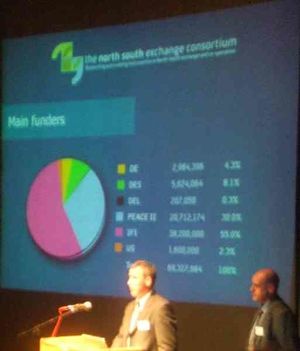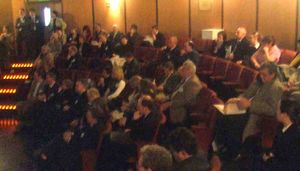Difference between revisions of "North South Exchange Consortium"
m |
|||
| Line 1: | Line 1: | ||
==[[N-S Educational Exchange Context|Context]]== | ==[[N-S Educational Exchange Context|Context]]== | ||
| + | The political changes in Northern Ireland have led to increased cooperation between the north and south of the island, particularly between education bodies. | ||
| + | The complexity of cooperation has required greater management, a task given to the [http://www.nsec.info North South Exchange Consortium (NSEC)] by the the [http://www.deni.gov.uk/ Department of Education (Northern Ireland)] and the [http:///www.education.ie Department of Education and Science (Ireland)]. | ||
| + | A key element of the [http://www.nsec.info NSEC] work plan is to develop and maintain lines of communication. [http://www.nsec.info NSEC], therefore, turned to e-technology. [http://www.nsec.info NSEC] believed the technology would: | ||
| + | #increase their capacity to run consultation initiatives, and, | ||
| + | #facilitate consultations with large stakeholder groups (i.e. school children). | ||
==[[N-S Educational Exchange Process and Planning|Process and Planning]]== | ==[[N-S Educational Exchange Process and Planning|Process and Planning]]== | ||
Revision as of 11:44, 26 April 2007
Contents
Context
The political changes in Northern Ireland have led to increased cooperation between the north and south of the island, particularly between education bodies.
The complexity of cooperation has required greater management, a task given to the North South Exchange Consortium (NSEC) by the the Department of Education (Northern Ireland) and the Department of Education and Science (Ireland).
A key element of the NSEC work plan is to develop and maintain lines of communication. NSEC, therefore, turned to e-technology. NSEC believed the technology would:
- increase their capacity to run consultation initiatives, and,
- facilitate consultations with large stakeholder groups (i.e. school children).
Process and Planning
N-S Educational Exchange E-consultation design
E-consultation for the NSEC launch event
Post-launch e-consultation design
Participant experiences
Consultation data generated
Key learning outcomes from the process
- Resource issues are always primarily present.
- Political considerations must be taken into account
- There are very real calendar considerations.
- The complexity of the consultation environment must be fully understood
- Each group of consultees needs to be clearly identified and separate assessments made
- E-consultation can play a role in developing an integrated communications strategy
Future work programme
Conclusion
The initial trial with the NSEC clearly identified some issues:
- Key issues were technological, personnel and financial resources. You cannot fully
automate a consultation, people still need to manage and run it.
- As has been identified in other trials, the technology proved easier than anticipated but
the process more complex than expected. The extensive promotion of the consultation process is essential to ensure participation. Thousands of schoolchildren don’t spontaneously visit the NSEC offices in Dundalk. So why expect them to visit nsec.info or nsec.e-consultation.org?
- Given the complexity of the consultation domain, which in NSEC case involved a
significant number of stakeholders who are both interrelated and interdependent, there is a clear need for extensive pre-consultation research. This would ensure that the precise context of that the e-consultation was understood.
- There are lessons to be learned on technical issues. Due to the increasing levels of
nuisance e-mails and spam that people are receiving there is an increasing unwillingness to download attachments or go to websites with which they are unfamiliar.
Newry launch
We attended the launch of the N-S Educational Consortium consultation in the Newry Arts Centre. http://www.e-consultation.org/guide/index.php?title=N-S_Educational_Exchange&action=edit


